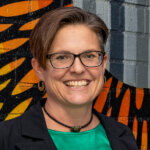SCN – Practical placemaking post-pandemic

Practical placemaking aids in reconnecting communities and revaluing outdoor public space. As COVID restrictions ease, the importance of practical placemaking in our post-pandemic world became clear.
Consequences of COVID
At last, the state of varied COVID restrictions across the country appears to be finally lifting, and people that have been confined to their homes and businesses that have been forced to close can start to emerge cautiously back into public life. This is a precarious moment with a high level of uncertainty and feelings of anxiousness about our work, economy, and wider community health.
COVID has taught us several key lessons, both positive and negative, about the fabric of our society. It has reminded us that we are deeply social beings, that crave and benefit from interactions with other people and nature. We all need to reconnect, to get out of our houses, and public spaces will play a key role in inviting people to re-engage as citizens in a healthy and responsible manner.
It also highlighted our inherent human-nature connection – we are not meant to be indoors all day. Skyrocketing levels of the requirements for mental health services paint a grim picture of human suffering over this time.
The pandemic has also enabled a massive technological shift, allowing jobs to be untaken purely online and giving people far more agency to work wherever they wish. The “Big Movers: Population Mobility in Australia” report details a huge shift of Millennials to regional areas, where they can take advantage of cheaper house prices, as they are no longer required to undertake the commute to the office. Within CBD areas people are no longer limited to frequenting the cafes near the office – they are free to select where and how they spend their lunch break, and simultaneously regain their active participation and reconnection within their local living community.

Revaluing outdoor public space
Practical placemaking becomes crucial as we seek to reconnect with each other and nature in the post-pandemic era. As we seek to reconnect both with each other and with nature, outdoor public spaces will play a key role. We know from global virologists such as Julian Tang, a virologist from England’s University of Leicester, that “the likelihood of a successful infection occurring from an exposure outside is likely less because the sunlight may damage the virus as it passes through the air between people.” Public space could be the key to opening up quickly and safely as social distancing is easier to manage in an open space and the risks of catching the virus lessened. Let’s spill the retail centres outdoors and encourage bike riding to centre for outdoor fitness classes, yoga classes, karate groups, and live music in a safe distanced environment with limited numbers to re-engage our communities.
We will need to encourage people out of their cars and reallocate roads to much-needed outdoor space in practical placemaking efforts. This will not only maintain physical distancing but also lead to multiple benefits, such as a Vitamin D boost from the sun and biophilic rewards from nature. Pavements and roads, town squares, and carparks are all community assets that are waiting to be reawakened through practical placemaking. Across the world, we are starting to see roads being closed off to traffic to increase the usable pedestrian space for community residents, exemplifying practical placemaking principles. In Seattle, we have seen the permanent closure to traffic of 20 miles of streets to enable residents to exercise and cycle. The Stay Healthy Street initiative has brought not only environmental benefits from reduced cars on the road but also bringing communities together through outdoor exercise.
How do we best use this time to allow people within their communities to contribute to re-energising their high streets, shopping malls, parks, and communities?

Rapid Community Engagement
Rapid community engagement is required in practical placemaking efforts to reshape our places in a meaningful way post-pandemic. We know that placemaking that benefits the community is most often shaped by the community and so the interventions must be local and specific to the place. There is not a one size fits all for all places. The real value of placemaking comes when we are not only reconnecting communities with each other but also reconnecting them with a deeper layer of place that is the natural place that has been there and is hidden beneath the layers of concrete.
The process and journey for practical placemaking are more important than the specific outcome. Focusing on the relationships that are formed through the process of engagement is the foundation for the vibrancy going forwards and the connection between people and their living environment. Rather than fixating on design outcomes, the focus needs to shift to focus on effective community engagement. Community health outcomes and benefits can be derived from a deeper reconnection of the community with its natural places. Real authentic community engagement is an important step on the pathway to a just and equitable post-COVID recovery.

This article by Associate | Regenerative Development Lead Claire Bowles was published in the Sept 2020 edition of SCN magazine.

Claire Bowles
Purpose Director
